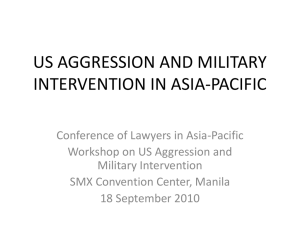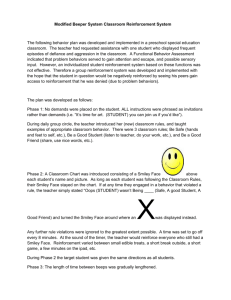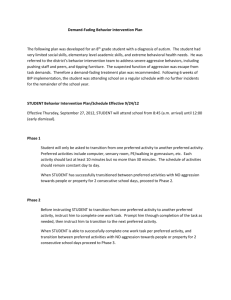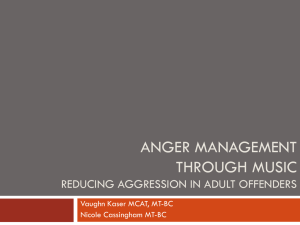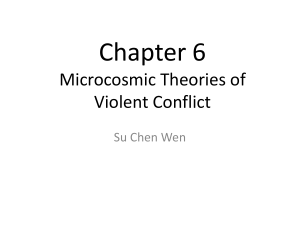Aggression - UWSP Home Page
advertisement
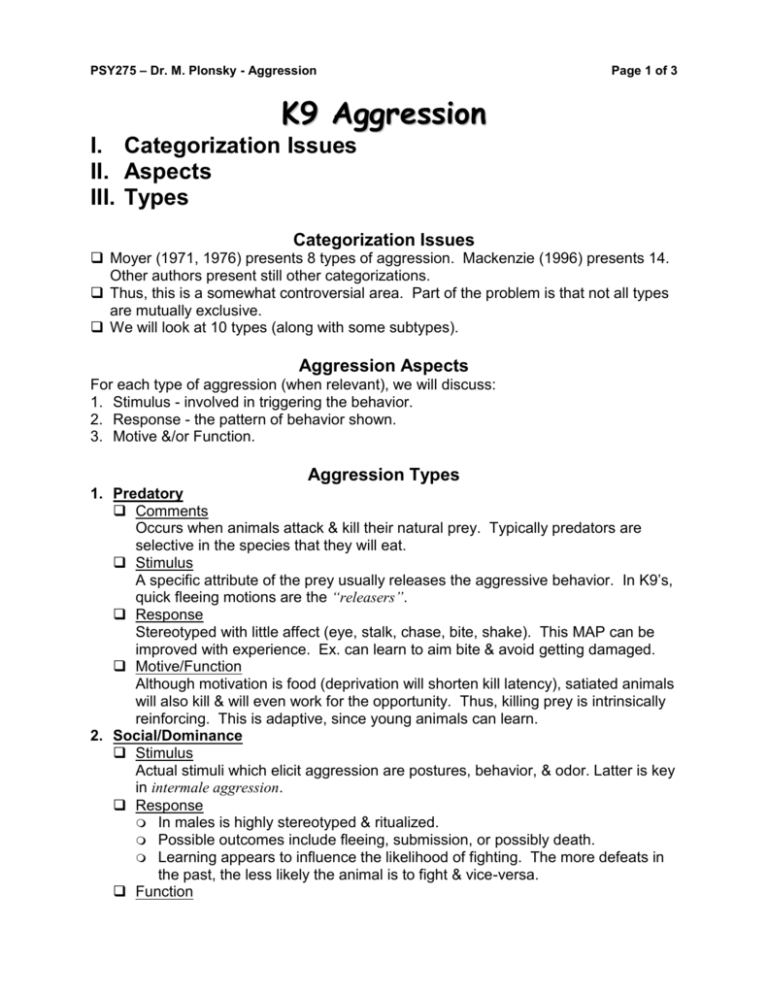
PSY275 – Dr. M. Plonsky - Aggression Page 1 of 3 K9 Aggression I. Categorization Issues II. Aspects III. Types Categorization Issues Moyer (1971, 1976) presents 8 types of aggression. Mackenzie (1996) presents 14. Other authors present still other categorizations. Thus, this is a somewhat controversial area. Part of the problem is that not all types are mutually exclusive. We will look at 10 types (along with some subtypes). Aggression Aspects For each type of aggression (when relevant), we will discuss: 1. Stimulus - involved in triggering the behavior. 2. Response - the pattern of behavior shown. 3. Motive &/or Function. Aggression Types 1. Predatory Comments Occurs when animals attack & kill their natural prey. Typically predators are selective in the species that they will eat. Stimulus A specific attribute of the prey usually releases the aggressive behavior. In K9’s, quick fleeing motions are the “releasers”. Response Stereotyped with little affect (eye, stalk, chase, bite, shake). This MAP can be improved with experience. Ex. can learn to aim bite & avoid getting damaged. Motive/Function Although motivation is food (deprivation will shorten kill latency), satiated animals will also kill & will even work for the opportunity. Thus, killing prey is intrinsically reinforcing. This is adaptive, since young animals can learn. 2. Social/Dominance Stimulus Actual stimuli which elicit aggression are postures, behavior, & odor. Latter is key in intermale aggression. Response In males is highly stereotyped & ritualized. Possible outcomes include fleeing, submission, or possibly death. Learning appears to influence the likelihood of fighting. The more defeats in the past, the less likely the animal is to fight & vice-versa. Function PSY275 – Dr. M. Plonsky - Aggression 3. 4. 5. 6. Page 2 of 3 Establishment of dominance hierarchies (reduce conflict, enable group to function as cohesive unit, & determine who mates). Fear-induced Stimulus When animal is afraid it tries to escape the situation. If it cannot, aggression may occur. Response Is a defensive reaction & is typically intense, with a strong affective component. Motive/Function Survival. Irritable Stimulus - Elicited by the affective reactions of anger &/or frustration. Exs.: Shock induced aggression in rats. Flanking - in protection, decoy pinches dog. “Pain induced” would fit here. Another variant is “redirected aggression”. Response Intensity varies with amount/type of stimulus. Typically impulsive & characterized by ANS arousal. In humans, may be directed at human, animal, or inanimate object. Motive/Function Remove the irritant and/or “let off steam”. Studies show behaving aggressively is highly reinforcing to irritated animals & people. Ex. irritated animals will work for the opportunity to be aggressive against a conspecific. Instrumental Comments - Aggression, like most other forms of behavior, can be learned. Stimulus - Is Variable Response - Aggression Motive/Function - To gain something pleasant or avoid/terminate something unpleasant. Territorial Stimulus An intruder. Various stimulus factors can influence. Territory defined as “any defended area”. Diagram of territory types. Feeding/hunting, rearing, mating, & sleeping. For dogs, the home (especially eating & sleeping areas), property, car, & even people & toys (“protective aggression”). Stimulus Factors Sex of the Defender - males are more likely to be territorial. Characteristics of the Intruder - some attack any intruders, other attack only conspecific strangers. Species of the Defender - some are just more territorial than others. Time of Year - breeding season is a time when territoriality is particularly likely. PSY275 – Dr. M. Plonsky - Aggression Page 3 of 3 Type of Territory - may determine the degree of intensity with which it is defended. Response Relatively common among animals (& highly variable). May bark, growl, chase, &/or bite (& bite may be a nip or something more serious). Motive/Function To get rid of intruder. 7. Maternal Stimulus Mother perceiving a threat to her young. Similar to fear-induced aggression. Mom perceives danger, but presence of young prevents escape. Important Variables More likely to attack a stranger. More likely to attack an adult than a youngster. More protective of young in nest than elsewhere. As the young age, intensity of maternal aggression decreases. The more maternal behavior is shown, the greater will be the maternal aggression. Response A direct attempt to harm the intruder. Persists until intruder leaves or dies. Often occurs without warning. Several variables are important. Motive/Function Removal of the threat. 8. Sex-related Stimulus Moyer believed sexual behavior & sex-related aggression were aroused by the same stimuli. Ex. Ferrets duke it out for a while before copulating. Aggression is also found in sexual activities of some humans (i.e., biting off pieces of eyebrows, etc.). Response Typically controlled & thus serious injury does not occur. However, exceptions (i.e., rape). Motive/Function Arousal? 9. Play Rough & tumble play is a way of practicing aggression skills. Typically is preceded or intermixed with the “play bow”. Analogous to football or other contact sports. 10. Medical - Due to a medical problem. Exs: Tumor Epilepsy Other CNS or endocrine abnormality Etc.


